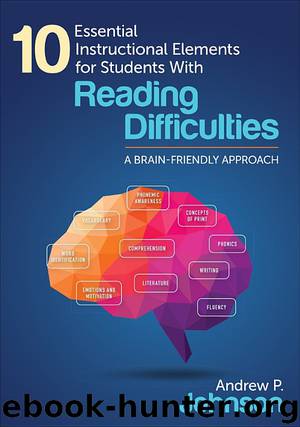Johnson. 10 Essential Instructional Elements for Students With Reading Difficulties by Andrew P. Johnson

Author:Andrew P. Johnson
Language: eng
Format: epub
Published: 2015-10-13T15:06:58.213000+00:00
Systematic Phonics Instruction
Phonics instruction should be systematic (Erickson, Hanser, Hatch, & Sanders, 2009; Houston, Al Otaiba, & Torgesen, 2006). However, systematic phonics instruction does not mean that you have to follow a rigid plan where all students are taught the same skills in the same way and in the same, prescribed order. Instead, systematic means that you have some sort of plan for addressing common letter-sound associations such as consonants, consonant blends, vowels, and word families. You can use a basic scope and sequence chart to give you a sense of what skills to teach (see Figure 10.1); however, the best scope and sequence chart is your students. Watch and listen to them as they read. See what skills they need and teach them these skills explicitly.
In general, it is best to start with letter sounds focusing on beginning consonants and vowel sounds. Gradually move into beginning consonant blends and then the common word families. As far as vowel diagraphs, diphthongs, the schwa sound, and r-controlled vowel sounds go, they are too inconsistent and infrequent to spend a lot of time with them. I will say this again, skillful readers use minimal-letter cues when identifying words. It makes sense then that phonics instruction be as minimal as possible.
Figure 10.1 Common Scope and Sequence Chart
Download
This site does not store any files on its server. We only index and link to content provided by other sites. Please contact the content providers to delete copyright contents if any and email us, we'll remove relevant links or contents immediately.
The Art of Coaching Workbook by Elena Aguilar(51081)
Trainspotting by Irvine Welsh(21573)
Twilight of the Idols With the Antichrist and Ecce Homo by Friedrich Nietzsche(18572)
Fangirl by Rainbow Rowell(9180)
Periodization Training for Sports by Tudor Bompa(8215)
Change Your Questions, Change Your Life by Marilee Adams(7690)
This Is How You Lose Her by Junot Diaz(6837)
Asking the Right Questions: A Guide to Critical Thinking by M. Neil Browne & Stuart M. Keeley(5712)
Grit by Angela Duckworth(5557)
Red Sparrow by Jason Matthews(5428)
Paper Towns by Green John(5141)
Room 212 by Kate Stewart(5073)
Ken Follett - World without end by Ken Follett(4686)
Housekeeping by Marilynne Robinson(4399)
The Sports Rules Book by Human Kinetics(4348)
Double Down (Diary of a Wimpy Kid Book 11) by Jeff Kinney(4244)
Papillon (English) by Henri Charrière(4229)
The Motorcycle Diaries by Ernesto Che Guevara(4054)
Exercise Technique Manual for Resistance Training by National Strength & Conditioning Association(4023)
